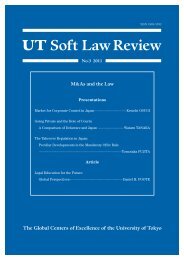UT Soft Law Review
UT Soft Law Review
UT Soft Law Review
You also want an ePaper? Increase the reach of your titles
YUMPU automatically turns print PDFs into web optimized ePapers that Google loves.
<strong>UT</strong> <strong>Soft</strong> <strong>Law</strong> <strong>Review</strong> No.2 2010reasonableness (or proportionality). As for the category of providing time, information andnegotiation opportunity, when the board of directors is allowed to implement the defensemeasure by its own decision, it is difficult to predict the threat of lack of time and information,which would satisfy the requirement of reasonableness in relation to the effect of the takeoverdefense measure that would dilute the acquiror’s equity stake.Shareholders’ decision making methodFujita: Thank you very much. Now, there is another issue: if shareholders should decidethe desirability of acquisition, what is the best method for shareholders’ decision? There aretwo different methods. One is to decide whether or not to approve the takeover defensemeasure by majority voting such as the general meeting of shareholders. This is like thecollective decision making just like to decide whether or not change all the directors by thegeneral meeting of shareholder. Another method is the sellout of the stocks by individualstockholder. The individual stockholders accept takeover bid or sell their stock to the personwho is buying the stocks in the market. This can be regarded as a stockholder’s consent to theacquisition in a wider sense. What is the merit and demerit of each of these two differentshareholders’ decision making methods? Is one method better than the other? Which oneshould be considered as a general rule? Professor Tanaka, what should we think about theseissues?Tanaka: As for the problem with the TOB, it may have a characteristic which can be called“coerciveness.” By “coerciveness” I mean that the TOB may give some pressure on theshareholders of the target company to sell their shares. One example is, if the acquirer takescontrol of the target company by the TOB, the acquirer might cash out all the remainingshares at the much lower price than the TOB price. Also, when the partial tender offer thatwould leave minority shareholders afterwards is placed, the value of the minority shares maydecrease after acquisition for several reasons. For example, the acquirer who then becomesthe controlling shareholder might exploit the acquired company, by way of makingtransactions with the acquired company with the conditions very disadvantageous for thelatter. In these cases, even if the shareholders are not satisfied with the conditions of thetakeover bid, they might be pressured to sell their shares. To deal with this problem, therecould be some merit in the shareholders’ meeting because usually there is no suchcoerciveness in the case of the shareholders’ meeting. In the TOB, shareholders’ decision onwhether or not to sell their shares is “asymmetric” in the following sense. Only those whoapplied to the tender offer bid can sell their shares, and those who didn’t apply cannot selltheirs. As a result, even shareholders who oppose to the takeover may decide to apply to theTOBs because they fear to become the minority shareholders and be exploited by the acquirerin case the TOB is successful by the tender of shares of other shareholders. The resolution ofthe shareholders’ meeting, in contrast, has the effect on all the shareholders. For example, ifimplementation of some defense measure is approved by the shareholders’ meeting, then the59





